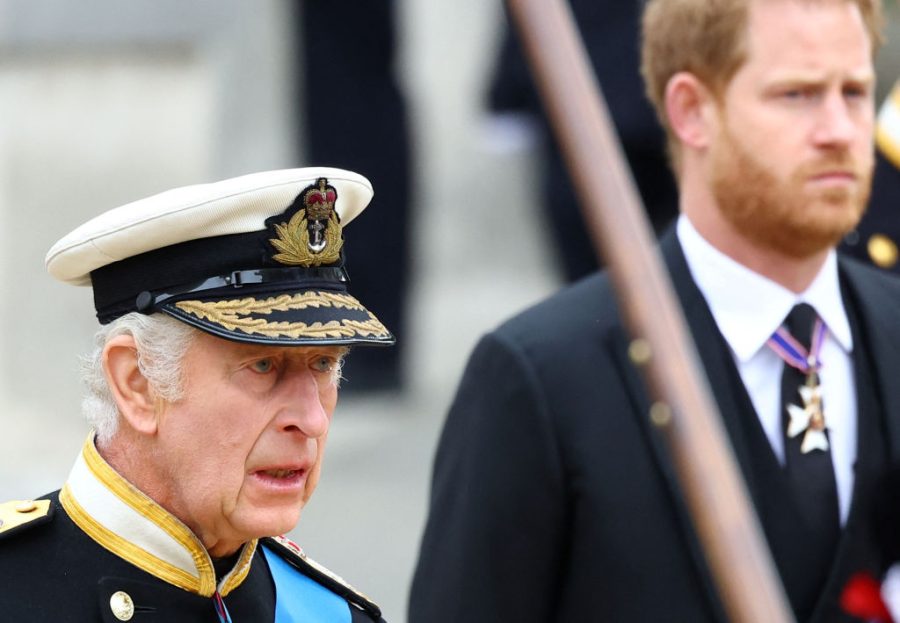If King Charles and Queen Camilla were feeling a tad apprehensive about their reception in Australia, they needn’t have worried.
Already half-way into their visit to Australia, the reception for the royal couple has been as warm and sunny as the Sydney weather over the weekend and, so far, all has gone very well.
The was a small glitch on Friday night, when the King and Queen’s plane was about to touch down at Sydney airport. The sails of the Sydney Opera House had been illuminated with images from Charles and Camilla’s previous visits. The King and Queen were supposed to be able to see the Opera House from the air, but were briefly delayed because a cruise liner berthed opposite obscured the projection. It was somehow appropriate that the offending liner was Cunard’s Queen Elizabeth.
After resting at the Australian governor-general’s official residence, Admiralty House – with views across Sydney Harbour to die for – the King and Queen were busy on Sunday. They attended Sunday service in a church where the foundation stone was laid by George V as a young midshipman. Then the main event of the day was celebrating the bicentenary of the oldest legislature in Australia, the Legislative Council of New South Wales.
In his brief speech there, the King gave a strong hint about what this visit means to him, not least because he must be considering his own mortality as he continues his battle with cancer.
‘With the sand of time encouraging brevity, it just remains for me to say what a great joy it is to come to Australia for the first time as Sovereign, and to renew a love of this country and its people which I have cherished for so long,’ the King said.
Today the King and Queen moved on to the national capital, Canberra, for an indigenous-flavoured day which included not one, but two, ceremonial Aboriginal ‘Welcomes to Country’. Both together and separately, they undertook a round of engagements. This included the now-notorious reception, hosted by Australia’s republican prime minister, Anthony Albanese, that all the premiers of the six states refused to attend. The British media last week were extremely critical of that collective snub, and rightly so. But so too have been the Australian media. Regardless of their mostly republican editorial leanings, newspapers here have treated the incident as the premiers being rude and discourteous to honoured guests who just happen to be the King and Queen.
Interactions so far with the general Australian public have been low-key. The big people’s occasion is a community barbecue in Sydney on Tuesday, complete with a typical Aussie ‘sausage sizzle’. The crowds so far have been modest but enthusiastic and friendly. Protests against the King and Queen’s visit have been minimal, and designed more to attract television cameras than to confront the royal couple.
The only real controversy occurred at the parliamentary reception. Australia’s elected serial pest, the radical Aboriginal activist turned independent senator, Lidia Thorpe, disrupted the King’s speech by shouting personal abuse and obscenities at the King. She also screamed denunciations of the monarchy and British settlement, including labelling it ‘genocide’.
To the disgusted onlookers, this was typically ugly Thorpe behaviour. She thrives on provocative, attention-seeking activist stunts. As she was ejected from the reception, Charles diplomatically ignored Thorpe and her outbursts, while observers like former prime minister Tony Abbott didn’t hold back in later expressing their contempt for Thorpe.
Australian senator Ms Thorpe, who has aboriginal heritage, heckled King Charles.
— Mukhtar (@I_amMukhtar) October 21, 2024
"You are not our King, you are not Sovereign… you have committed genocide against our people." pic.twitter.com/Z3LyAOUg2I
While behaving more civilly, republican activists have also been out and about. Outside big events for the monarchy like last year’s coronation, royal tours are the only occasions these days when Australia’s republicans get any media attention at all, so they make hay when they can. The Australian Republic Movement has been hawking T-shirts advertising this visit as an Oasis-like ‘farewell tour’. This is crassly tactless given the King’s personal condition. On the whole, however, republicans have been on their ‘best behaviour’, as promised by New South Wales’s republican premier, Chris Minns.
True, this visit is not on a grand scale, as traditional and full-scale royal tours tend to be. The low-key official events, and the visit’s general informality, may have been dictated by the King’s health and circumstances. But the trip has already demonstrated a friendly affection and intimacy reflecting that Australia is comfortable with the King, and the King is comfortable with an Australia that has evolved almost beyond recognition over his lifetime. Even those Australians ambivalent about the monarchy respect Charles and Camilla as people, and especially appreciate the King making such an arduous trip at all in the circumstances.
Australia’s ties with the monarchy may be anachronistic to committed republicans and, indeed, many other Australians. Yet it’s that indefinable sense of King and country that shows why, according to an extensive pre-visit newspaper poll, three-quarters of Australians think Australia will never become a republic in their lifetime – even if they themselves are republicans.







Comments